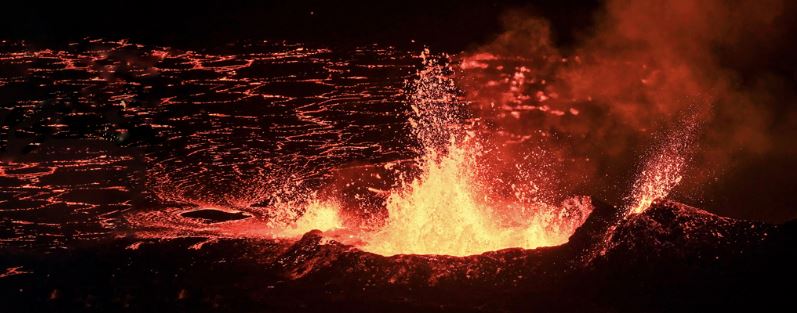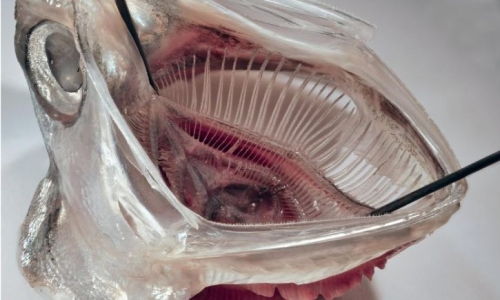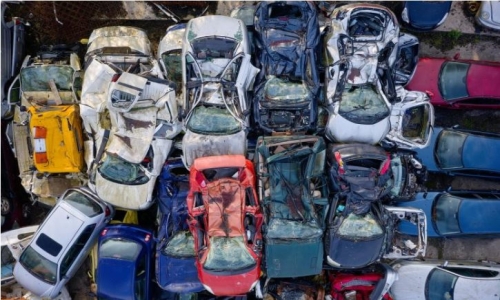


 3:2:50
3:2:50  2024-08-03
2024-08-03  1199
1199

To experience a volcanic eruption is to witness nature's raw power. If you would like to see one for yourself, Iceland is a great location for it. Since 2021, seven eruptions have taken place along the Reykjanes Peninsula, close to Reykjavík.
These recent Icelandic eruptions have garnered attention from Earth scientists like me. The eruptions help us understand how volcanoes work in incredible detail. My team has been taking samples from the erupting lava from the Reykjanes Peninsula and finding some interesting results.
One of our findings suggests that magma from the first eruption pooled just under the island's surface, where it built up the energy to spectacularly erupt. This initial burst of volcanism made it easier for more eruptions to follow after it.
Why is Iceland called the land of fire?
The island nation of Iceland is sometimes called "the land of ice and fire." Early settlers witnessed several great "fires" – or volcanic eruptions – along the Reykjanes Peninsula.
After about 800 years without a volcanic event on the Reykjanes Peninsula, the Fagradalsfjall volcano roared to life on March 19, 2021. Then, two more discrete volcanic events occurred at Fagradalsfjall in 2022 and 2023. Subsequently, four more eruptions have taken place to the west at the Sundhnúkur fissure system in 2023 and 2024.
While these eruptions provide an incredible spectacle, they also have the power to wreak havoc.
The recent Sundhnúkur eruptions threatened the fishing town of Grindavík, the geothermal power plant at Svartsengi and Iceland's premier tourist destination: the geothermal spa the Blue Lagoon.
Lava erupted within the town limits of Grindavík, and only human-made berms have prevented further destruction.
What makes Iceland so volcanically active?
Iceland is a unique place on Earth. It is part of a huge chain of volcanoes submerged in the center of the Atlantic Ocean, with Iceland being exposed above the ocean's surface.
This volcanic chain is known as the Mid-Atlantic Ridge, and it plays an essential role in plate tectonics.
Plate tectonics describes how the vast, rigid plates that make up Earth's crust slide past, into and under one another. Their behavior slowly reshapes Earth's surface.
In some locations, the plates collide to form mountain ranges like the Himalayas. In other locations, one plate slides under another, creating volcanoes and earthquakes, like in Japan.
On the Mid-Atlantic Ridge – which stretches between the South Atlantic and Arctic Ocean – the plates pull apart, allowing molten magma to pour through. This magma solidifies into volcanic crust and creates new parts of the tectonic plates.
Geologists have also found a buoyant, hot plume of rocky material rising from deep in the Earth that intersects with the Mid-Atlantic Ridge under Iceland.
This plume, along with several other similar plumes in the central and southern Atlantic, may have triggered the formation of the Atlantic Ocean basin more than 200 million years ago.
The plate tectonics associated with the Mid-Atlantic Ridge and the hot, rocky plume under Iceland together form Iceland's volcanoes.
Scientists have been able to show that previous eruptions on the Reykjanes Peninsula are not random in time or space. Instead, they occur in periods that last centuries and along the same volcanic zones.
These patterns indicate that these volcanic periods happen when vast tectonic forces pull apart the Reykjanes Peninsula. It appears that, while the plates pull apart evenly, volcanism along the Reykjanes ridge segment pulses with time.
What's driving the eruption?
Many groups, including my colleagues from Iceland, have been collecting the erupted lavas on a near-daily basis. The collected samples provide a vital scientific time series of the eruptions.
Taking a volcanic time series is like regularly drawing someone's blood to understand their medical condition. In this case, though, the blood is red-hot lava.
An initial study by another team in 2022 suggested that the mantle – the solid geological layer beneath the Earth's crust – was melting to feed the lavas in Iceland, and that the lavas' chemical makeup was changing over time.
They suggested that these changes had to do with where and when the melting was happening in the mantle.
In July 2024, my research team and I published a longer time-series of the lavas from the eruption using a sensitive chemical method that helped us understand the lavas' composition and origin.
The layer of basaltic rock that people live on in Iceland extends to a depth of about 9 miles (15 kilometers). It's part of Earth's crust.
The mantle that lies directly beneath this crust is distinct – it's made mostly of minerals like olivine that form a rock called peridotite. The magmas feeding these volcanic eruptions come from mantle peridotite.
The chemical method that my team used revealed that the first magmas feeding these eruptions rose from the mantle, but got stuck beneath the surface in a magma chamber for as long as a year. The rocks in the chamber walls melted into the magma, and we could see traces of them in our analyses.
Our research also suggests that the magmas gained water, carbon dioxide and other gases from sitting in the magma chamber. This water and gas allowed the magma to build up enough pressure to break through the surface and erupt as lava.
Magma pooling in the crust can trigger explosive eruptions – the beginnings of eruptions like those in Iceland or in La Palma in the Canary Islands in 2021 may require this type of pooling.
What might we expect in the future?
History tells researchers that these eruptions will likely last a long time. The volcanoes will erupt periodically every few years, for days to months at a time, for up to several hundred years into the future.
Generations of geologists and volcanologists are likely to forge their careers in Iceland, and millions of geo-tourists will get to experience the hauntingly beautiful eruptions.
With all these eruptions, Icelanders will have to adapt. Lava flows can disrupt infrastructure such as the Svartsengi geothermal plant, and volcanic gases can cause health problems.
The Fagradalsfjall and Sundhnúkur eruptions have already provided scientists with a treasure trove of data and insight into how volcanoes work.
Continued study of volcanism on the Reykjanes Peninsula will help scientists understand how, when and why eruptions take place, and to better manage the hazards associated with living with volcanoes.
Reality Of Islam |
|

Researchers

A new chip-

A large inf

Choosing th
 9:3:43
9:3:43
 2018-11-05
2018-11-05
10 benefits of Marriage in Islam
 7:5:22
7:5:22
 2019-04-08
2019-04-08
benefits of reciting surat yunus, hud &
 9:45:7
9:45:7
 2018-12-24
2018-12-24
advantages & disadvantages of divorce
 11:35:12
11:35:12
 2018-06-10
2018-06-10
 6:0:51
6:0:51
 2018-10-16
2018-10-16
 7:32:24
7:32:24
 2022-02-14
2022-02-14
 12:47:1
12:47:1
 2022-12-20
2022-12-20
 10:43:56
10:43:56
 2022-06-22
2022-06-22
 10:47:11
10:47:11
 2022-11-22
2022-11-22
 5:58:12
5:58:12
 2021-12-18
2021-12-18
 2:13:43
2:13:43
 2022-05-27
2022-05-27
 4:2:19
4:2:19
 2022-10-10
2022-10-10
 5:41:46
5:41:46
 2023-03-18
2023-03-18
| LATEST |